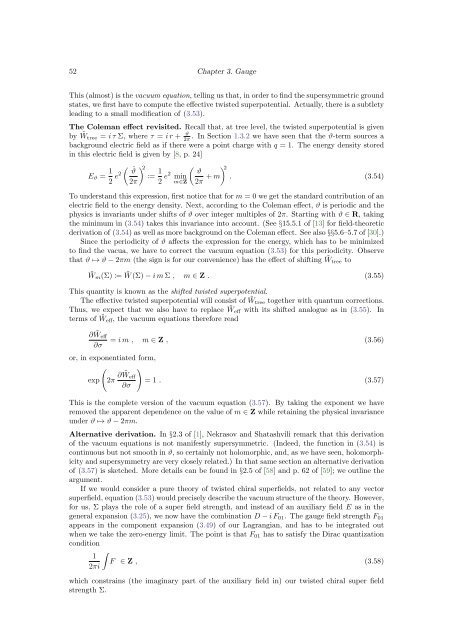The Bethe/Gauge Correspondence
The Bethe/Gauge Correspondence
The Bethe/Gauge Correspondence
You also want an ePaper? Increase the reach of your titles
YUMPU automatically turns print PDFs into web optimized ePapers that Google loves.
52 Chapter 3. <strong>Gauge</strong>This (almost) is the vacuum equation, telling us that, in order to find the supersymmetric groundstates, we first have to compute the effective twisted superpotential. Actually, there is a subtletyleading to a small modification of (3.53).<strong>The</strong> Coleman effect revisited. Recall that, at tree level, the twisted superpotential is givenby ˜W tree = i τ Σ, where τ = i r + ϑ2π. In Section 1.3.2 we have seen that the ϑ-term sources abackground electric field as if there were a point charge with q = 1. <strong>The</strong> energy density storedin this electric field is given by [8, p. 24]E ϑ = 1 ( ) 2 ˆϑ2 e2 := 1 ( ) 2 ϑ2π 2 e2 minm∈Z 2π + m . (3.54)To understand this expression, first notice that for m = 0 we get the standard contribution of anelectric field to the energy density. Next, according to the Coleman effect, ϑ is periodic and thephysics is invariants under shifts of ϑ over integer multiples of 2π. Starting with ϑ ∈ R, takingthe minimum in (3.54) takes this invariance into account. (See §15.5.1 of [13] for field-theoreticderivation of (3.54) as well as more background on the Coleman effect. See also §§5.6–5.7 of [30].)Since the periodicity of ϑ affects the expression for the energy, which has to be minimizedto find the vacua, we have to correct the vacuum equation (3.53) for this periodicity. Observethat ϑ ↦→ ϑ − 2πm (the sign is for our convenience) has the effect of shifting ˜W tree to˜W m (Σ) := ˜W (Σ) − i m Σ , m ∈ Z . (3.55)This quantity is known as the shifted twisted superpotential.<strong>The</strong> effective twisted superpotential will consist of ˜W tree together with quantum corrections.Thus, we expect that we also have to replace ˜W eff with its shifted analogue as in (3.55). Interms of ˜Weff , the vacuum equations therefore read∂ ˜W eff∂σ = i m , m ∈ Z , (3.56)or, in exponentiated form,( )exp2π ∂ ˜W eff∂σ= 1 . (3.57)This is the complete version of the vacuum equation (3.57). By taking the exponent we haveremoved the apparent dependence on the value of m ∈ Z while retaining the physical invarianceunder ϑ ↦→ ϑ − 2πm.Alternative derivation. In §2.3 of [1], Nekrasov and Shatashvili remark that this derivationof the vacuum equations is not manifestly supersymmetric. (Indeed, the function in (3.54) iscontinuous but not smooth in ϑ, so certainly not holomorphic, and, as we have seen, holomorphicityand supersymmetry are very closely related.) In that same section an alternative derivationof (3.57) is sketched. More details can be found in §2.5 of [58] and p. 62 of [59]; we outline theargument.If we would consider a pure theory of twisted chiral superfields, not related to any vectorsuperfield, equation (3.53) would precisely describe the vacuum structure of the theory. However,for us, Σ plays the role of a super field strength, and instead of an auxiliary field E as in thegeneral expansion (3.25), we now have the combination D − i F 01 . <strong>The</strong> gauge field strength F 01appears in the component expansion (3.49) of our Lagrangian, and has to be integrated outwhen we take the zero-energy limit. <strong>The</strong> point is that F 01 has to satisfy the Dirac quantizationcondition12πi∫F ∈ Z , (3.58)which constrains (the imaginary part of the auxiliary field in) our twisted chiral super fieldstrength Σ.
















